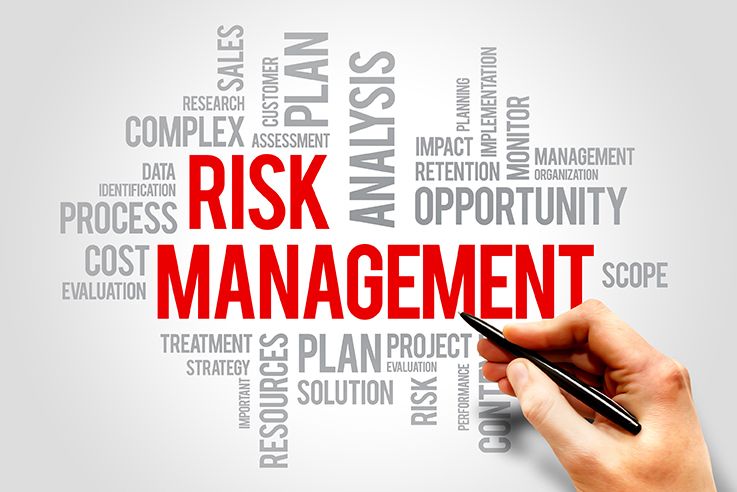IT RISK MANAGEMENT
Risk assessment helps organizations identify, reduce and manage risks to prevent their recurrence. A large amount of the IT Budget has to be spent on technologies and processes to find and assess those risks, determine their impact and spend considerable effort to fix them. Trying to assess actual risks against all the noise requires a new way of thinking about risk, how to address those risks and how to engage in proactive risk management going forward.


IT RISK & IT’S MANAGEMENT
- Information risk is a calculation based on the likelihood that an unauthorized user will negatively impact the confidentiality, integrity, and availability of data that you collect, transmit, or store.
- IT risk management consists of the policies, procedures, and technologies that a company uses to mitigate threats from malicious actors and reduce information technology vulnerabilities.
RESPONSIBILITIES OF AN IT RISK MANAGER
- They are responsible for identifying potential hazards and creating procedures that staff members must follow to eliminate or manage those risks.
- As part of their duties, they have to make sure that the IT systems are set up to best support the corporate objectives.
- IT risk managers then keep an eye on the security of the IT systems to ensure that they are protected, and it is their duty to ensure that the systems are not compromised in the event of an attack.
- IT risk managers pay attention to more than just external dangers to data. They control all pertinent risk factors, including the possibility of data loss or system failure.
- They may actively participate in developing and executing policies that are intended to reduce risks such as reputational risk.
- They may actively participate in developing and putting into practise rules that are intended to show conformity with industry standards, as well as taking into account other factors like reputational risk.

SKILLS REQUIRED BY AN IT RISK MANAGER
- For this role in information technology, computer abilities are expected.
- In order to evaluate data and recognise potential threats, IT risk managers also need intellectual abilities.
- For them to be able to figure out how to lower such dangers, they also require problem-solving abilities.
- Because they must create clear rules, alert management to potential risk issues, and effectively communicate information about policy changes, excellent communication skills are crucial.
- Business acumen is crucial since IT risk managers work in a corporate setting and must take corporate goals and objectives into account when deciding how to run IT systems or what policies to set up to safeguard the organisation.
WHY ARE IT RISK MANAGEMENT SERVICES BENEFICIAL?
- Easier To Identify Trouble Spots:
Prudent risk management procedures assist you in locating problem areas in ongoing projects so you can solve the issue before it gets worse. When managing multiple projects, it is simple to identify which one is not proceeding as expected and to take the necessary corrective action. Any project management technique already in use should incorporate risk management procedures with ease.
- Minimize Surprises:
Your business teams can quickly detect potential problem areas thanks to effective risk management, and they can also communicate with the right individuals at the right time. In this manner, taking mitigation measures can be done immediately. Since everyone participates in problem solutions, early identification of potential issues fosters team spirit.
- Better Quality Data:
Good risk management procedures provide your senior leadership with higher-quality data for decision-making. Instead of using out-of-date reports, you base your decisions on current information.
- Better Communication:
The quality of communication between senior stakeholders and project teams is enhanced through prudent risk management. Discussions about challenging subjects are supported with factual and recent information. Additionally, it makes it simple to include important external players in the debate and include them in finding solutions to emerging problems. Such additions strengthen positive working connections and foster a sense of shared ownership in your company's success.
- Better Budgeting:
Good risk management practices involve incorporating schedule planning and cost planning in your budgeting. This means including extra time as may be needed, resources, and money in the budget. Eliminating the guesswork in budgeting for unforeseen costs cuts down on overheads, results in fewer overruns, and plans are better implemented.
THE EASE OF IMPLEMENTING IT RISK MANAGEMENT SERVICES:
- Without IT Risk Management Services it is almost impossible to identify and analyze potential vulnerabilities with an enterprise IT network. Organizations can better prepare for cyber attacks and work to minimize the impact of a cyber incident, should it occur.
- An IT risk management program's procedures and regulations can assist direct future choices about risk management while keeping an eye on business objectives.
- When managing multiple projects, it is simple to identify which one is not proceeding as expected and to take the necessary corrective action. Any project management technique already in use should incorporate risk management procedures with ease.
NEED HELP? CALL US ON +91 86524 82227
QUERY
frequently asked questions
- Identify potential points of vulnerability
- Cloud-based data collection, transmission, and storage locations pose a higher risk of theft because organizations often lack visibility into the effectiveness of their controls. Thus, server hardware in an on-premises location may be a lower risk than a cloud-based server. When engaging in an information risk assessment, you need to identify the myriad of locations and users who “touch” your information.
- Not only do you need to know where your data resides, but you also need to know what data you collect. Not all types of data are created equally.
- Identifying the types of data your organization stores and aligning that to the locations where you store your information act as the basis for your risk analysis.
- Now that you’ve reviewed all data assets and classified them, you need to analyze the risk. Each data asset type resides in a particular location. You need to determine how the risk each poses overlaps and impacts the potential for a malicious actor to attack.
- Setting your risk tolerance means deciding whether to accept, transfer, mitigate, or refuse the risk. An example of a control for transferring risk might be purchasing cyber risk liability insurance.
- Malicious actors never stop evolving their threat methodologies. As companies get better at identifying and protecting against new ransomware strains, malicious actors have responded by focusing more on cryptocurrency and phishing. In other words, today’s effective controls might be tomorrow’s weaknesses.














